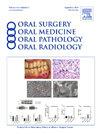Automated characterization of arterial calcification in dental cone beam computed tomographic images as a risk factor for cardiovascular disease
IF 2
3区 医学
Q2 DENTISTRY, ORAL SURGERY & MEDICINE
Oral Surgery Oral Medicine Oral Pathology Oral Radiology
Pub Date : 2025-02-04
DOI:10.1016/j.oooo.2024.11.019
引用次数: 0
Abstract
Objectives
This study aims to train and deploy a deep convolutional neural network, to automatically detect and localize arterial calcifications on cone beam computed tomography (CBCT) studies. Additionally, radiomics analysis will be performed to further characterize these calcifications using parameters such as, texture, voxel spatial distribution, signal intensity, etc., to estimate the risk of cardiovascular incidents
Study Design
CBCT scans acquired at Stony Brook University School of Dental Medicine Dental Care Center between 2015 and 2022 will be used for this study. Studies will be designated as determined by an oral and maxillofacial radiology resident, and confirmed by the report in the patient's Axium chart, signed by a board-certified oral maxillofacial radiologist. These volumes will be segmented by an oral radiology resident and pre-doctoral dental students and checked by a board certified oral and maxillofacial radiologist before submission to the artificial intelligence (AI) team.
An algorithm will be developed and trained on the mentioned data with the aims of (1) detecting carotid artery calcifications by using volumetric segmentations with unanimous interobserver agreement on the segmentation accuracy; (2) independently localizing and segmenting carotid artery calcifications (cervical and intracranial); (3) determining the accuracy at which the algorithm localizes, and segments carotid artery calcifications with explainable outcomes; and (4) correlating the extractable features of these findings with the risk of cardiovascular disease including stroke.
Results
The first set of CBCT volumes were segmented, verified, and are being processed for algorithm development and training. Results will be presented at the American Academy of Oral and Maxillofacial Radiology meeting.
Conclusion
It is expected that a CNN can be reliably trained to detect and segment arterial calcifications with accuracy similar to a trained oral and maxillofacial radiologist. Furthermore, the CNN is anticipated to deliver a predictive risk score for cardiovascular disease incidents based on the radiographic features.
求助全文
约1分钟内获得全文
求助全文
来源期刊

Oral Surgery Oral Medicine Oral Pathology Oral Radiology
DENTISTRY, ORAL SURGERY & MEDICINE-
CiteScore
3.80
自引率
6.90%
发文量
1217
审稿时长
2-4 weeks
期刊介绍:
Oral Surgery, Oral Medicine, Oral Pathology and Oral Radiology is required reading for anyone in the fields of oral surgery, oral medicine, oral pathology, oral radiology or advanced general practice dentistry. It is the only major dental journal that provides a practical and complete overview of the medical and surgical techniques of dental practice in four areas. Topics covered include such current issues as dental implants, treatment of HIV-infected patients, and evaluation and treatment of TMJ disorders. The official publication for nine societies, the Journal is recommended for initial purchase in the Brandon Hill study, Selected List of Books and Journals for the Small Medical Library.
 求助内容:
求助内容: 应助结果提醒方式:
应助结果提醒方式:


